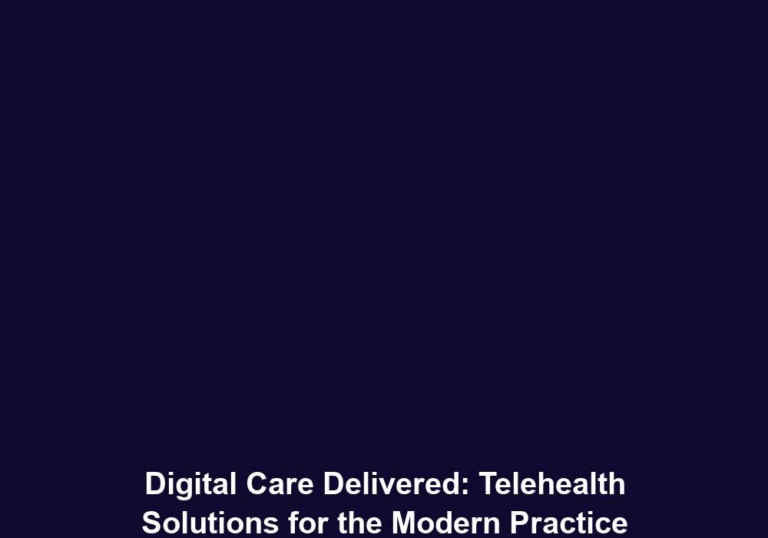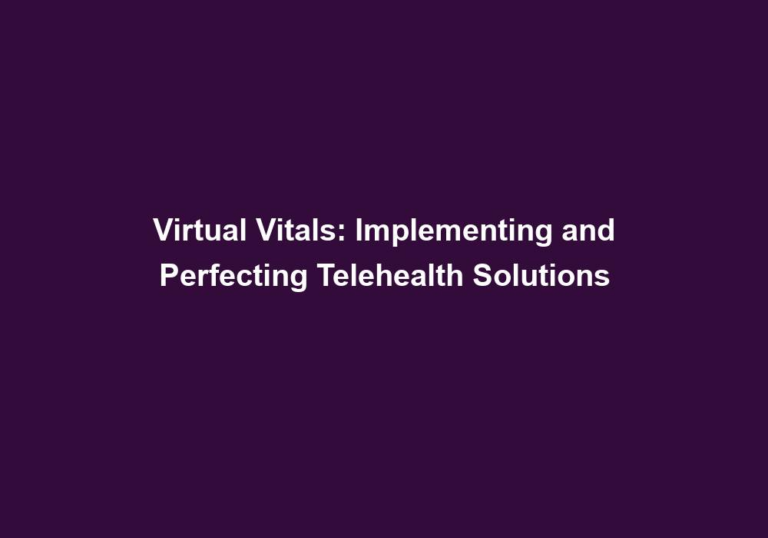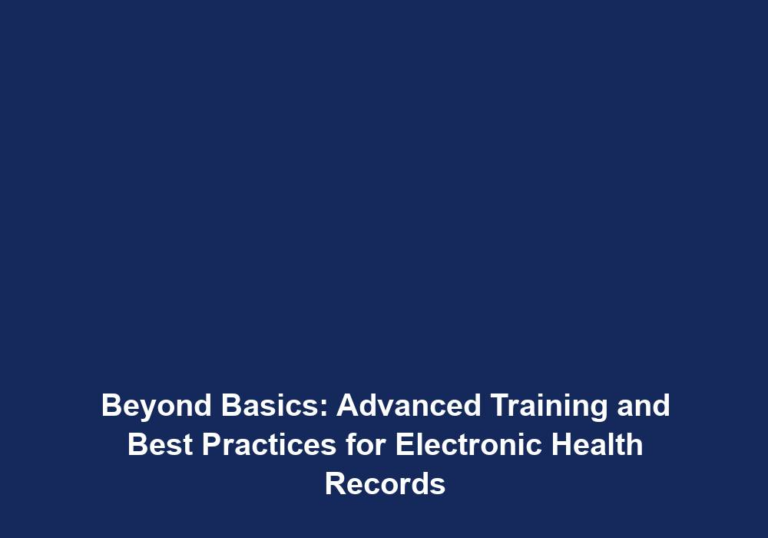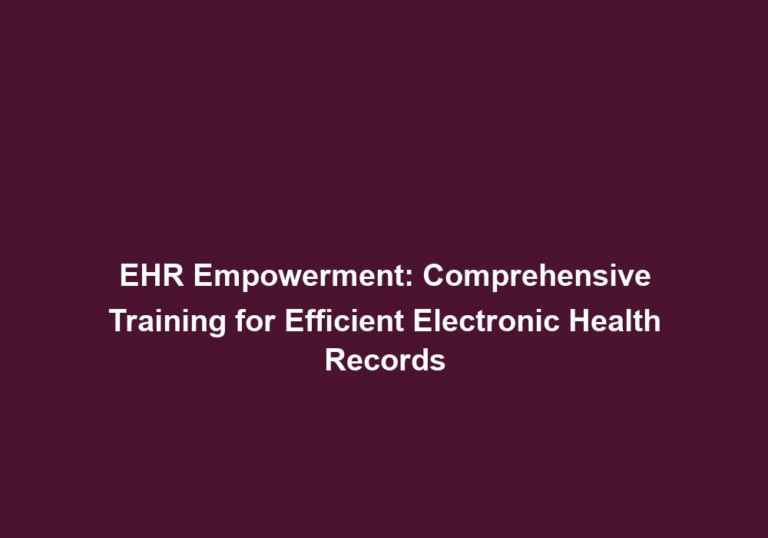Record Revolution: Training Staff for Optimized EHR Use
Electronic Health Records (EHRs) have revolutionized the healthcare industry by streamlining and improving patient care, record-keeping, and overall operational efficiency. However, the successful implementation and utilization of EHR systems heavily rely on well-trained staff members who can harness the full potential of these digital tools. In this article, we will delve into the importance of training staff for optimized EHR use and provide insights on effective training strategies.
The Significance of Training Staff for EHR Use
- Enhanced Efficiency: A well-trained staff can navigate through EHR systems with ease, significantly reducing the time spent on administrative tasks and enabling them to focus more on providing patient care. This increased efficiency leads to improved patient satisfaction and better utilization of resources.
- Staff members who are proficient in using EHR systems can quickly access patient information, update medical records, and schedule appointments, allowing them to dedicate more time to direct patient care.
- Streamlined administrative tasks, such as automated billing and appointment reminders, improve efficiency and reduce the likelihood of errors or missed opportunities.
- With EHR systems, healthcare providers can easily retrieve and analyze patient data, leading to more informed diagnoses and treatment plans.
- Improved Accuracy and Patient Safety: Proper training ensures that staff members understand how to accurately input and retrieve patient data, reducing the chances of errors and ensuring patient safety. By following standardized protocols, healthcare providers can make informed decisions and avoid potential medical mistakes.
- Training programs should emphasize the importance of data accuracy and integrity, teaching staff members how to enter information correctly and verify its completeness.
- Staff should be trained on using relevant clinical decision support tools within the EHR system, which can help identify potential drug interactions, allergies, or other critical patient information.
- By adhering to best practices and standardized workflows, healthcare professionals can minimize errors, avoid duplicate or conflicting entries, and improve patient safety.
- Compliance with Legal and Regulatory Requirements: EHR systems must adhere to various legal and regulatory requirements, such as HIPAA. Staff training ensures that employees are aware of the privacy and security measures necessary to protect patient information, preventing potential data breaches and legal implications.
- Training programs should cover topics such as patient privacy, confidentiality, and the importance of safeguarding electronic health information.
- Staff members should be educated on the legal implications of mishandling patient data and the potential consequences for non-compliance.
- Regular training and updates are essential to ensure staff members stay informed about changing regulations and can adapt their practices accordingly.
- Effective Communication and Collaboration: Training staff on EHR use fosters effective communication and collaboration within the healthcare team. By understanding how to document and share patient information electronically, healthcare professionals can coordinate care efficiently, leading to better patient outcomes.
- EHR systems enable seamless sharing of patient information among healthcare providers, ensuring that everyone involved in a patient’s care has access to comprehensive and up-to-date data.
- Training programs should emphasize the importance of clear and concise documentation to facilitate effective communication among healthcare team members.
- By utilizing EHR functionalities such as secure messaging and shared care plans, staff members can collaborate more effectively, leading to improved care coordination and patient satisfaction.
Designing Effective EHR Training Programs
To maximize the benefits of EHR systems, healthcare institutions should develop comprehensive training programs tailored to their staff’s needs. Here are some essential components to consider when designing an effective EHR training program:
1. Needs Assessment:
Conduct a thorough needs assessment to identify the specific training requirements of different staff members. This assessment should consider individual roles, skill levels, and prior experience with EHR systems. By understanding the gaps in knowledge, training programs can be customized accordingly.
- Analyze the different roles within the healthcare organization and determine the specific EHR functionalities each role requires.
- Evaluate the current skill levels of staff members and identify areas where additional training may be necessary.
- Consider the prior experience of staff members with EHR systems, as this can impact the training approach and pace.
2. Engaging Training Materials:
Develop engaging training materials, such as interactive tutorials, videos, and simulations, to provide hands-on experience with using EHR systems. These materials should be easily accessible and available in multiple formats, catering to various learning styles.
- Interactive tutorials and videos can demonstrate specific tasks within the EHR system, allowing staff members to learn by example.
- Simulations provide a safe environment for staff members to practice using the EHR system without the risk of making mistakes that could impact patient care.
- Supplement training materials with user guides and reference documents that staff members can access for quick assistance during their day-to-day work.
3. Role-Based Training:
Tailor training programs to different job roles within the healthcare organization. For example, nurses may require training on documenting patient care, while administrative staff may need to learn about scheduling and billing functionalities. Job-specific training ensures that staff members gain the necessary skills directly related to their roles.
- Identify the specific EHR features and workflows that are relevant to each job role and incorporate them into the training curriculum.
- Provide role-based scenarios and exercises that allow staff members to practice using the EHR system in the context of their daily responsibilities.
- Offer opportunities for cross-training, enabling staff members to gain a broader understanding of the EHR system and its impact on other roles within the organization.
4. Ongoing Training and Support:
Implement ongoing training and support mechanisms to keep staff members up to date with system updates and best practices. This can include periodic refresher courses, webinars, and a dedicated team of EHR experts who can address user queries and provide guidance when needed.
- Regularly schedule refresher courses to reinforce key concepts and introduce new features or updates to the EHR system.
- Conduct webinars or lunch-and-learn sessions to facilitate continuous learning and encourage staff members to share their experiences and best practices.
- Establish a help desk or support ticket system that allows staff members to seek assistance from EHR experts when encountering challenges or needing guidance.
5. Hands-on Practice:
Encourage staff members to actively engage with the EHR system through hands-on practice sessions. This will help them become familiar with the system’s interface, functionalities, and shortcuts, fostering confidence and competence in utilizing the EHR effectively.
- Provide dedicated practice environments or sandboxes where staff members can explore the EHR system without the fear of making mistakes.
- Assign realistic tasks and scenarios that simulate real-world situations, allowing staff members to apply their knowledge and skills in a practical setting.
- Offer opportunities for peer-to-peer learning and collaboration, where staff members can share tips and tricks for using the EHR system efficiently.
6. Assessments and Feedback:
Incorporate assessments and feedback mechanisms throughout the training program to gauge staff members’ progress and identify areas for improvement. This feedback loop ensures continuous learning and skill enhancement, enabling staff members to become proficient EHR users.
- Conduct quizzes or knowledge checks at various stages of the training program to assess staff members’ understanding of the material.
- Provide constructive feedback to staff members, highlighting areas where improvement is needed and offering resources or additional training to address those areas.
- Encourage staff members to provide feedback on the training program itself, allowing for continuous improvement and customization based on their input.
Overcoming Challenges in EHR Training
Implementing EHR training programs can come with its own set of challenges. Here are a few common challenges and strategies to overcome them:
- Resistance to Change: Some staff members may be resistant to change, particularly if they are accustomed to traditional paper-based methods. To overcome this, emphasize the benefits of EHR systems, address concerns, and provide ample support throughout the training process.
- Clearly communicate the advantages of EHR systems, such as improved efficiency, enhanced patient safety, and better coordination of care.
- Involve staff members in the decision-making process and provide opportunities for them to voice their concerns or suggestions.
- Offer one-on-one support and mentoring for staff members who may require additional assistance in transitioning from paper-based methods to electronic records.
- Limited Time and Resources: Healthcare institutions often operate in high-pressure environments with limited time and resources. To address this, consider offering flexible training options, such as self-paced modules or on-the-job training, to accommodate staff schedules and minimize disruptions in daily operations.
- Provide online training modules that staff members can access at their convenience, allowing them to learn at their own pace without interfering with patient care responsibilities.
- Incorporate on-the-job training, where staff members receive hands-on guidance and support while performing their regular duties.
- Allocate dedicated time for training and ensure that staff members understand the importance of investing in their own professional development.
- Technological Competency: Not all staff members may be equally comfortable with technology. Provide additional support and resources, such as one-on-one training or IT assistance, to help bridge the technological competency gap and ensure all staff members can effectively utilize EHR systems.
- Offer basic computer literacy training for staff members who may require it, ensuring they have the foundational skills necessary to navigate the EHR system.
- Assign dedicated IT support personnel or help desk resources to address technical issues or questions that staff members may encounter during training or while using the EHR system.
- Provide ongoing IT training and resources to keep staff members updated on new technology trends and advancements that may impact their use of EHR systems.
Conclusion
Effective training of staff members is crucial for optimized EHR use within healthcare organizations. By investing in comprehensive training programs and addressing individual needs, healthcare institutions can empower their staff to leverage EHR systems to their full potential. This, in turn, leads to enhanced efficiency, improved patient safety, and better overall healthcare outcomes. Remember, ongoing training, support, and assessments are key to maintaining staff proficiency and adapting to evolving EHR technologies.







